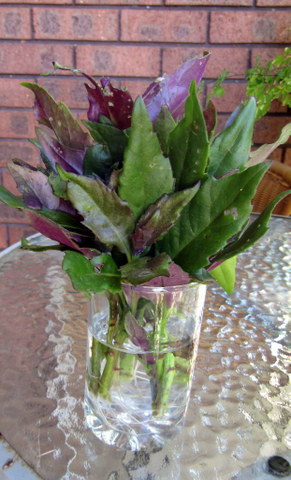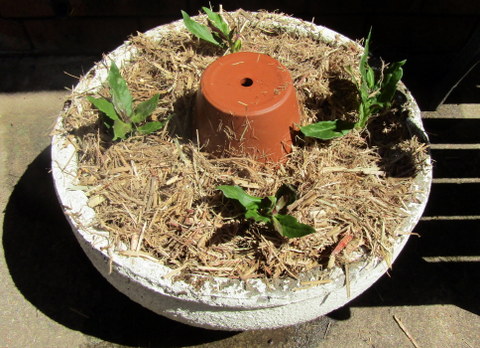About a year ago, a Chinese friend of ours gave me some Okinawa spinach (hung tsoi or hong tsoi in Chinese), which I have been able to propagate, and it goes really well in any of the leafy vegetable recipes in our recipe section. It can be eaten raw or cooked, but it can go a bit slimy if overcooked.
Okinawa Spinach (Gynura crepioides) is a fast growing and productive perennial leaf crop which can grow up to 0.7 metres high, but it can become invasive if left to its own devices. It has green leaves with a purple underside so that as well as being productive it is also quite an attractive plant.
It is a tropical plant and so is very frost tender, but we have found that growing it next to a brick wall of the house with morning sun has allowed it to survive what has been for us a fairly hard winter with frost down to -3°C. My daughter also grows it and she has found, that even if the foliage is killed by the frost, it will re-sprout from the base of the plant when the weather warms up a bit. If all else fails you could use it as a perennial grown as an annual in areas where they temperature dropped too low in winter and just replant it every year. It likes moist, well drained fertile soil (what doesn’t?) with a pH of 6.0 to 6.5.
It is ridiculously easy to propagate from cuttings. Prune the cuttings to about 150 – 200mm long and remove the leaves from the bottom half of the cutting. Place the cuttings in water and renew the water if it starts to get cloudy. I did not use any stimulant (honey, willow water) for the cuttings to rapidly produce roots. The cuttings will send out roots and then can be planted into the soil in spring or summer. We planted ours into a found concrete pot with an olla made from two small terra cotta pots in the centre to allow easy watering and to keep the plant moist in hot dry weather.
Okinawa spinach can be grown in full sun if the water is kept up to it but also likes partial shade. As previously mentioned, our pot of spinach gets morning sun up until roughly midday then is shaded by the house in the afternoon.
Okinawa spinach seems to be affected by few pests or diseases but can be subject to attack from aphids on occasion, but if you can put up with that for a while and let the ladybirds breed up, they will keep the aphids in check.






